
Official Edgar Rice Burroughs Tribute and Weekly Webzine Site
Since 1996 ~ Over 15,000 Webzines and Webpages In Archive
Master of Imaginative Fantasy Adventure
Creator of Tarzan® and "Grandfather of American Science Fiction"
Volume 7973a
Nakedness on Mars:
It’s Complicated
by Fredrik Ekman
This article has been updated and extended since its publication in ERB-APA #160.Whenever some Edgar Rice Burroughs fan on Facebook posts an image from the John Carter movie, or from the 1970s Marvel comic series, or just about any Barsoom illustration where the women (yes, women; no-one reacts to the men) are not entirely naked, you are bound to see a comment along the lines of “She has way too much clothes on her.” It just seems that a lot of fans are entirely convinced that Burroughs intended for all of the women on Barsoom to go around stark naked, or at the very most with stripper nipple pasties and a pair of miniscule panties. But is that actually what Burroughs meant, or is it just a result of these people’s wishes and oversexualized imaginations?
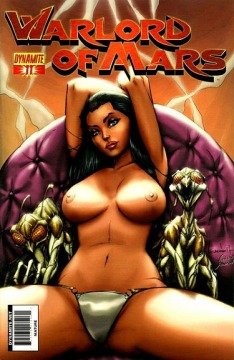
Overdressed(?) Dejah Thoris(?) with soraks(?)
making herself comfortable on one of Dynamite’s comic covers.When questioned about the subject, fans generally respond that Burroughs expressed it quite clearly in A Princess of Mars, in that first detailed description of Dejah Thoris:
“She was as destitute of clothes as the green Martians who accompanied her; indeed, save for her highly wrought ornaments she was entirely naked, nor could any apparel have enhanced the beauty of her perfect and symmetrical figure.” (PM/8)This does seem clear and unambiguous. But is it the whole story? In the following, I will take a closer look upon this subject.
Evidence in A Princess of Mars
In addition to that most famous passage, there are several references to nakedness in A Princess of Mars. In fact, there is an even earlier reference, in Chapter 3, where Tars Tarkas is first described: “[He] threw down his spear and small arms, and came around the end of the incubator toward me, entirely unarmed and as naked as I, except for the ornaments strapped upon his head, limbs, and breast.” And in the next chapter, the entire tribe is described: “With the exception of their ornaments all were naked.”In Chapter 11, Dejah Thoris compares Martians with Earth men: “Earth men, almost without exception, cover their bodies with strange, unsightly pieces of cloth, and their heads with hideous contraptions the purpose of which we have been unable to conceive”, and in Chapter 20, we learn that the atmosphere factory keeper “wore but a single article of clothing or adornment, a small collar of gold from which depended upon his chest a great ornament”.
In Chapter 23, Carter further tells us about the incident when he saved the atmosphere factory: “when I fell unconscious at the little doorway I had been naked.”
In Chapter 4, Burroughs writes that at least one Martian wears “beautifully wrought leather trappings [and] a short cape of white fur lined with brilliant scarlet silk”. There are several other references to (leather) trappings, both for green and red men, and in Chapter 10 we find that John Carter also wears a cape. Nevertheless, the evidence suggests that for the most part, the Martians go about unclothed.
Harness
The word “harness” is never used in the first Martian book. It shows up in the second book, as we are told that the leather harness “is the only manner of clothing worn by Martians other than silk capes and robes of silk and fur for protection from the cold after dark.” (GM/3)This very unambiguous quote is supported by several similar ones later in the series. One of the most notable is the description of John Carter as he comes to visit with Burroughs: “his otherwise naked body [was] trapped with a jewel-encrusted harness from which there hung at one side an ornate short-sword and at the other a pistol of strange pattern.” (CM/Prologue)
And when Kar Komak, the bowman of Lothar, first appears, he is repeatedly described as naked. Explaining his condition, he says that “my harness and my weapons had faded away with my fellows, leaving me naked and unarmed in a hostile country far from Lothar” (TMM/10). This evidence is, admittedly, not very clear, but notice that he says that it is his lack of harness and weapons that makes him naked; there is no word about any kind of clothes.
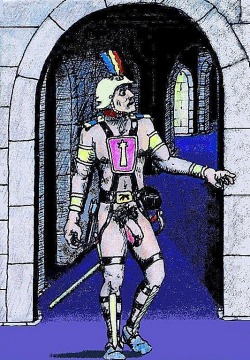
Is this the way Burroughs imagined it? All harness and little else? Dongs dangling?
Panel from A Princess of Mars comic by James Killian Spratt.But it is also clear that, in some instances, the harness itself covers parts of the body. When Gahan of Gathol admired Tara, he saw “a rounded breast, part hid beneath its jeweled covering.” (CM/1)
At one point, Ras Thavas “had removed the harness down to his waist” (MMM/1), suggesting that there may be parts of the harness reaching below the waist.
As Carthoris declared his love for Thuvia, “he knelt at her feet, raising a bit of her harness to his lips.” (TMM/14) This gives very little information, but it does tell us this much: Thuvia is not entirely naked. She is wearing a harness, parts of the harness is not tight-fitting, and from the context we can also infer that it is a harness for domestic use, not a fighting or flying harness. To what extent does it cover her nakedness? That is not something Burroughs goes into at this point.
As Tavia begs Tan Hadron to take her life, rather than let her fall victim to savages, “[h]er breast was bared to receive my dagger” (FMM/15), so a completely bare breast is not the norm, at least not for women.
Tavia also gives us a very rare example of Martian crossdressing. While escaping from the clutches of Tul Axtar, she fooled some guards into believing that she was a man: “I went to the quarters of a soldier whom I knew to be on guard and stole harness and I cut off my long hair and painted my face that I might look more like a man” (FMM/4).
When Tan Hadron first met her, he only heard her voice. When he eventually laid eyes on her, he too was fooled by her looks. The following conversation ensued:
“‘I thought you were a girl’ I blurted out.
“A fine mouth spread into a smile that revealed strong, white teeth. ‘I am,’ she said.
“‘But your hair—your harness—even your figure belies your claim.’ ” (FMM/4)It should be noted, that later it is said that “the scant harness of Barsoom hides little and certainly did not hide the rounded contours of Tavia’s girlish body” (FMM/5). Yet, I feel that if Tavia was able, if only for a few minutes, to fool Hadron and several others into believing her a male, then her breasts and genitalia must have been hidden from view.
Complementary Clothing?
It might be wondered, did Tavia’s harness really cover her body that well, or did she in fact wear other pieces of clothing? There are several instances when one may wonder if complementary clothes were involved.Hor Kai Lan, after John Carter had stolen his harness and weapon in the pits of Horz, is described as “almost naked” (LG-1/8), suggesting that he wore something else beside his harness.
And when John Carter meets Llana of Gathol in the pits of Horz, nothing is said about her clothes. Later, as Llana dons the harness of a dead Panar warrior, there is no indication that she was already wearing another harness. Had she initially been completely naked (that is, without either harness or clothes), I am sure Burroughs would have pointed that out, so the implication is that she was wearing something, over (or in addition to) which she later wears the Panar harness.
In an interesting scene, Ulysses Paxton leaves his bath “to find harness and trappings awaiting me in the adjoining chamber […] but there were no weapons with them.” (MMM/1) So if there are both harness and trappings, and the trappings are not weapons, then what are they? My Oxford Universal Dictionary describes trappings as “Ornaments; dress; embelishments; external, superficial, and trifiling decorations.” A pretty broad definition, thus, and one which could possibly infer clothes or coverings of some sort.
These passages are admittedly not entirely clear, yet they do suggest the possibility that the harness may not after all be the sole piece of clothing.
Parallels with the Tarzan Series
The Tarzan series, too, has its nakedness issue, although considerably less controversial. In Tarzan of the Apes, Chapter 3, Tarzan decides that he cannot continue to go around naked in the jungle:
“At the bottom of his little English heart beat the great desire to cover his nakedness with clothes for he had learned from his picture books that all men were so covered, while monkeys and apes and every other living thing went naked.”Hence, Tarzan stole from a native man the first of his iconic loincloths. I have searched the three first books in the Tarzan series for all instances (after donning that cloth) where Tarzan is described as naked. The books are Tarzan of the Apes (TA), The Return of Tarzan (RT) and The Beasts of Tarzan (BT).
In a few cases, it is just part of Tarzan that is described as naked, e.g. “naked loins” or “naked feet”, but when it comes to describing the entire man, I found a total of 16 instances. In two of these, his nakedness is accentuated by his loincloth, for example: “he turned to behold a giant, naked but for a loin cloth and a few metal ornaments, standing motionless before him.” (TA/16)
Seven instances describe him as “half-naked” or “almost naked”, e.g. “What he saw was the giant figure of an almost naked white man emerging from the bush.” (BT/14) This type of description is especially common in Beasts, with six instances.
But in seven more instances, Tarzan is only described as “naked”, even though we know that he is wearing his loincloth. A couple of examples follow: “For a naked man to drag a shrieking, clawing man-eater forth from a window by the tail to save a strange white girl, was indeed the last word in heroism.” (TA/15) “A little more than a year ago I was a naked beast of prey in an African jungle.” (RT/5)
In other words, it was perfectly legitimate for Burroughs to use the word “naked” to describe a man who actually was wearing something, even if it was only a loincloth. Does this extend to the Barsoom series? The issue is not clear. In fact, the word “loincloth” is not to be found in the entire series, nor have I found any similar pieces of apparel. Yet, the possibility cannot be ruled out.
Nakedness as Identity Marker
Tarzan aside, all the suggestions mentioned earlier about additional trappings or apparel besides the harness are from the latter half of the Barsoom series. During that half, there is a shift in the use of harness descriptions and nakedness.About the time of The Master Mind of Mars (the sixth book), neutral or positive descriptions of harness and nakedness become increasingly rarer, and in fact disappear entirely after Swords of Mars (the eighth book), whereas it becomes more common to give such descriptions only for odd people or exceptional situations. An example is Lum Tar O, the mad embalmer of Horz, who “was naked except for the harness which supported a sword and a dagger.” (LG-1/8) This may have been a way to emphsize his madness; no other citizen of Horz is described thus.
During a rite of Tur, Burroughs describes twenty slaves that are “naked but for their scant leather harness.” (MMM/12) Why does Burroughs point out their nakedness, if all Barsoomians are naked anyway? The only explanation seems to be that the other people present are not similarly unclad, so that the slaves become an exception to the rule, not the norm.
Burroughs describes a tribe in the Toonolian marshes: “They were a savage lot; and as they came closer, I saw that they were stark naked, their bushy hair standing out in all directions, their faces and bodies painted to render them more hideous even than Nature had intended them to be.” (SMM/19) In the following chapter, we learn that the savage men of Gooli are “entirely naked except for a simple harness.” (SMM/20) The cannibals of U-Gor are described thus: “naked savages with tangled, unkempt hair, filthy bodies and degraded faces”. (FMM/14)
The nakedness of savages gives no direct information about nakedness in general, but it is interesting to consider why Burroughs described these tribes as naked: he wanted to emphasize their primitive nature, and contrast them with the more civilized Barsoomians.
As with all the mentions of possible clothing, note that these descriptions of exceptional nakedness are all from the second half of the series. In the early books, I can find no such descriptions, where nakedness is used to reinforce someone’s identity as mad, savage or enslaved (unless you count the green men in A Princess of Mars).
Burroughs’ Opinion
There are several published letters where Burroughs voiced strong opinions about artists’ interpretations of his creations. He would comment upon things like facial expressions, poses, hair colour, etc. But to my knowledge, he never made a comment about anyone being overdressed, in spite of artists like Frank Schoonover and J. Allen St. John (both of whom he expressed considerable satisfaction with, in general ways) regularly depicting Barsoomians wearing kilts (or similar pieces covering the genitals and loins), loincloths, mantles and full gowns, among other pieces of clothing. The women in particular were fairly well covered.
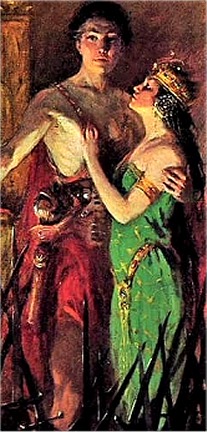
Detail from St. John’s cover for The Warlord of Mars (1919).
John Carter not only wears a cape, but also some kind of kilt or wrapping
to cover the hips and legs. Dejah Thoris wears a full-length, albeit sleeveless, dress.ERBzine #423 (the CHASER entry for The Gods of Mars) has a quote ascribed to “Russ Cochran Auction”. Burroughs apparently rejected a commissioned cover, because of excessive blood and nudity. The nudity in question is actually very tasteful. Thuvia is seen in the background, clad only in a shawl over the head and a very brief skirt or shorts. One breast is seen, but she is partly turned away, and her hair covers the nipple. There is nothing sexual or risqué about her pose or situation.
Unfortunately, there is no reference to any specific letter or other published text that Burroughs’ opinion was cited from, but if he reacted that strongly to such innocent nakedness, then what would he have had to say about Dynamite’s risqué comic covers, for instance?
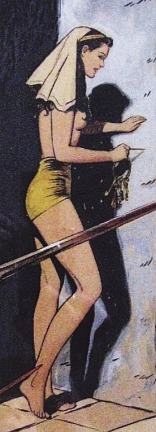
Detail from C.C. Beck’s rejected cover for The Gods of Mars.
This may have been for the 1948 reprint edition, which ended up with the classic Schoonover painting.The Verdict
The nakedness issue is, and will remain, controversial because of the cultural taboos on sexuality and the naked (female) body, but also because Burroughs changed his mind during the course of his career. It appears that, in A Princess of Mars, Burroughs genuinely intended the Barsoomians to go around stark naked, save for perhaps a cape, a few leather straps, some ornaments, and (given the indications in the Tarzan series) just possibly briefs or a loincloth. In later books, the harness covered more and more, and may have eventually been complemented with other apparel. Burroughs very possibly took inspiration from the artists depicting his heroes, not least his favourite St. John.Whatever Burroughs’ intentions about the nakedness issue, there is one thing we can be sure of: he would have hated the modern interpretation, where a near-naked Dejah Thoris (or some other Barsoomian babe) strikes a sexy and evocative pose, looking more like a stripper or a porn star than a proud and dignified Martian princess.
Sources
For this article, the entire Barsoomian series of books has been examined,
and in addition three Tarzan books. Quotes have been drawn from the following books:A Princess of Mars [PM]
The Gods of Mars [GM]
Thuvia, Maid of Mars [TMM]
The Chessmen of Mars [CM]
The Master Mind of Mars [MMM]
A Fighting Man of Mars [FMM]
Synthetic Men of Mars [SMM]
Llana of Gathol [LG]Tarzan of the Apes [TA]
The Return of Tarzan [RT]
The Beasts of Tarzan [BT]The following images have been used:
* A Princess of Marscover by Frank Frazetta from the 1970 Doubleday Edition
• Warlord of Mars #11 variant cover by Alé Garza, Dynamite, 2011
• A Princess of Mars comic adaptation by James Killian Spratt
• The Warlord of Mars cover by J. Allen St. John, A. C. McClurg (publisher), 1919
• The Gods of Mars rejected cover by C. C. Beck


This article is featured in our
Fredrik Ekman Tribute Series
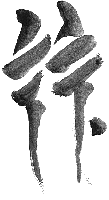
BILL HILLMAN
Visit our thousands of other sites at:
BILL and SUE-ON HILLMAN ECLECTIC STUDIO
ERB Text, ERB Images and Tarzan® are ©Edgar Rice Burroughs, Inc.- All Rights Reserved.
All Original Work ©1996-2024 by Bill Hillman and/or Contributing Authors/Owners
No part of this web site may be reproduced without permission from the respective owners


